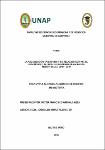| dc.contributor.advisor | Arrué Flores, Jorge Luis | |
| dc.contributor.author | Arevalo Meza, Victor Francisco | |
| dc.date.accessioned | 2023-07-12T17:59:42Z | |
| dc.date.available | 2023-07-12T17:59:42Z | |
| dc.date.issued | 2023 | |
| dc.identifier.uri | https://hdl.handle.net/20.500.12737/9191 | |
| dc.description.abstract | During this last decade, the per capita income of the jungle macro region has gone from being three quarters of the national average in 2008, to less than half by 2018. In addition to this great economic lag, in the jungle macro region it is also located among one of the departments with the worst indicators of social development, percentage of children with anemia and child malnutrition in Peru. In this sense, this seeks to determine the relationship between tax collection, economic growth, the level of unemployment and the average study income of the Jungle Macro Region, the period 2009 - 2019. This is done through a methodology of a non-experimental nature, quantitative and correlational design, specifically a panel data linear regression model and a Pearson correlation analysis are used for the variables of the jungle Macroregión; In our results we corroborate the existence of a positive relationship between tax collection and economic growth and the level of income of the regions of the Jungle Macroregión, in the same way we corroborate the negative relationship between the level of unemployment and tax collection. Therefore, we conclude that the growth of Peru's GDP is also based on its relationship with the taxation of legal entities in our country, thus showing that these variables have increased proportionally over the years. Like any economic phenomenon, unemployment is a factor in society, which can generate an imbalance in the supply and demand of goods and/or services. This variable has a significant relationship with tax collection and its reduction in the economies can benefit income, the GDP of the regions and government collection. | en_US |
| dc.description.abstract | Durante esta última década, el ingreso per cápita de la macro región selva, ha pasado de ser tres cuartas partes del promedio nacional en 2008, a ser menos de la mitad para el 2018. Además de este gran rezago económico, en la macro región selva también se ubica entre uno de los departamentos con peores indicadores de desarrollo social, porcentaje de niños con anemia y desnutrición infantil del Perú. En este sentido, este estudio busca Determinar la relación entre la recaudación tributaria, el crecimiento económico, el nivel de desempleo y el ingreso promedio de la Macro Región Selva, durante el periodo 2009 – 2019.esto se realiza mediante una metodología de naturaleza no experimental, de tipo cuantitativa y de diseño correlacional, en específico se utiliza un modelo de regresión lineal de datos de panel y un análisis de correlación de Pearson para las variables de la Macroregión selva; en nuestros resultados corroboramos la existencia de una relación positiva entre la recaudación tributaria y el crecimiento económico y el nivel de ingresos de las regiones de la Macroregión selva, de igual forma corroboramos la relación negativa entre el nivel de desempleo y la recaudación tributaria. Por lo tanto, concluimos que el crecimiento del PBI de Perú también se basa en su relación con la tributación de las personas jurídicas en nuestro país, mostrando así que estas variables han aumentado proporcionalmente a lo largo de los años.
Como todo fenómeno económico, el desempleo es un factor de la sociedad, lo que puede generar un desequilibrio en la oferta y demanda de bienes y/o servicios. Esta variable tiene una relación significativa con la recaudación tributaria y su disminución en las economías puede beneficiar el ingreso, el PBI de las regiones y la recaudación del gobierno. | es_PE |
| dc.format | application/pdf | es_PE |
| dc.language.iso | spa | es_PE |
| dc.publisher | Universidad Nacional de la Amazonía Peruana | es_PE |
| dc.rights | info:eu-repo/semantics/openAccess | * |
| dc.rights.uri | https://creativecommons.org/licenses/by/4.0/ | * |
| dc.subject | Auditoría fiscal | es_PE |
| dc.subject | Impuestos | es_PE |
| dc.subject | Recaudación de impuestos | es_PE |
| dc.subject | Producto interno bruto | es_PE |
| dc.subject | Desempleo | es_PE |
| dc.title | La recaudación tributaria y su relación con PBI, el desempleo y el nivel de ingresos en la macro región selva, 2009 - 2019 | es_PE |
| dc.type | info:eu-repo/semantics/masterThesis | es_PE |
| thesis.degree.discipline | Maestría en Auditoría | es_PE |
| thesis.degree.grantor | Universidad Nacional de la Amazonía Peruana. Escuela de Postgrado | es_PE |
| thesis.degree.name | Maestro(a) en Auditoría | es_PE |
| dc.subject.ocde | https://purl.org/pe-repo/ocde/ford#5.06.02 | es_PE |
| renati.author.dni | 43839196 | |
| renati.advisor.orcid | https://orcid.org/0000-0002-6914-9415 | |
| renati.advisor.dni | 41578572 | |
| renati.type | https://purl.org/pe-repo/renati/type#tesis | es_PE |
| renati.discipline | 411017 | es_PE |
| renati.level | https://purl.org/pe-repo/renati/level#maestro | es_PE |
| renati.juror | Zevallos Egoavil, Hugo Luis | |
| renati.juror | Melgarejo Mariño, David Miguel | |
| renati.juror | Solsol Hidalgo, Edgar Alberto | |
| dc.publisher.country | PE | es_PE |





